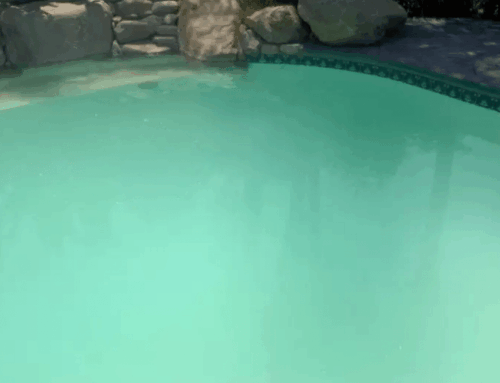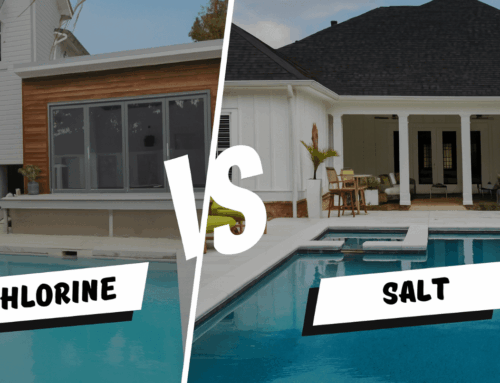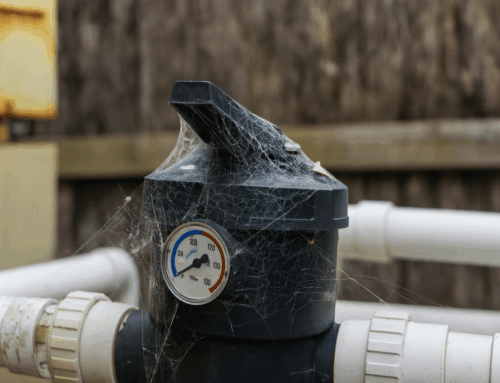
A saltwater chlorinator is one of the easiest and most effective ways to keep your swimming pool clean, sanitised, and algae-free without having to add liquid chlorine or chlorine tablets every few days or manually measuring and handling these chemicals and risking exposure to chlorine gas. The automatic salt chlorinator simply dissolves salt in the pool water and then electrolytically produces a continuous flow of chlorine for a sanitising effect.
This guide explains exactly how a salt chlorinator works, the main parts of the system, and the benefits compared to conventional chlorine pools as well as tips for maintaining your swimming pool chlorinator.
What Is a Saltwater Pool Chlorinator
A saltwater chlorinator is sometimes also called a swimming pool chlorine generator, or simply swimming pool chlorine generators. It is an automatic device that produces chlorine from sodium chloride dissolved in your pool water. The device converts the salt into chlorine using an electrolytic cell, which sanitises the pool with fewer chemicals and handling of strong chemical odours. The saltwater chlorinator is more expensive to install than a conventional chlorine pool, but it can save money over time due to lower chemical and maintenance costs.
Saltwater in a swimming pool is not the same as ocean water. It has a significantly lower concentration of salt, which feels softer and less irritating on the skin and eyes. Saltwater chlorinators avoid the strong chlorine smell that many people associate with chlorine pools.
Helpful Resource – What Pool Chemicals Do I Need
Main Components of a Saltwater Chlorinator
A saltwater chlorinator consists of two key parts:
1. Control Board
The control board regulates the chlorine production process. It lets you adjust the chlorine output, monitor salt levels, and in some models even manage chlorine output remotely via a remote or mobile device. Some units also have indicators such as a low salt light to alert you when salt needs to be added.
2. Salt Cell (Electrolytic Cell)
The salt cell is installed in your pump and filter system, usually after the automatic pool chlorinator and pool filter. As water passes through the cell, the control board sends an electric current through coated plates. This process breaks down sodium chloride into free chlorine, which sanitises the pool water and then naturally reverts back to salt, ready to be reused. The lifespan of a salt cell in a chlorinator is typically around 3-7 years and requires periodic replacement.
How a Saltwater Chlorinator Works Step by Step
- Adding Salt
Pool grade salt or mineral salt blends are added directly to the swimming pool. The ideal salt level depends on the chlorinator model but is generally around 3,000 to 4,500 parts per million.
- Circulation Through the Filter System
The pool pump moves water through the pool filter and into the salt cell.
- Chlorine Production
Inside the electrolytic cell, electricity converts the dissolved salt into hypochlorous acid and sodium hypochlorite. These are the same sanitising agents found in liquid chlorine or chlorine tablets.
- Water Returns Sanitised
The chlorine sanitises the pool, killing bacteria and algae. The chlorine then reverts to salt, completing the cycle without needing additional sanitising chemicals.
- Minimal Maintenance Required
Because the chlorinator produces its own chlorine, you avoid the need for floating dispensers, inline chlorinators, or automatic chemical feeders for day to day sanitising.
Benefits of a Saltwater Pool Chlorinator
- Consistent Chlorine Levels – Keeps enough chlorine in the pool to prevent algae growth without spikes or drops.
- Fewer Chemicals – Requires fewer chemicals compared to conventional chlorinated pools.
- Gentle on Skin and Eyes – Softer water feel with less irritation.
- Reduced Odours – Avoids harsh chemical odours and the strong chlorine smell of chlorine pools.
- Minimal Maintenance – A chlorinator requires minimal maintenance beyond regular cleaning and water testing.
- Long Term Savings – Lower ongoing chemical costs once the system is installed.
- Remote Control Options – Some automatic pool chlorinators allow chlorine output to be adjusted remotely.
Maintenance Tips for Saltwater Pool Chlorinators
While saltwater chlorinators work automatically, some care will keep them performing well:
- Conduct Regular Water Testing – Check free chlorine levels, pH, and salt levels to keep the pool balanced.
- Clean the Salt Cell – Calcium deposits can reduce efficiency. Clean every 3 to 6 months.
- Inspect the Control Board – Ensure chlorine output is set correctly for the season.
- Run the Filtration Pump Enough – Most systems need 6 to 10 hours of filtration pump operation daily.
- Check for Excessive Wear – Inspect the cell plates and seals to prevent excessive wear.
- Shock the Pool if Needed – After heavy rain, cold water conditions, or high bather loads, use a higher chlorine dose to restore balance.
Common Pool Chlorinator Types
While this article focuses on saltwater pool chlorinators, there are other options:
- Floating Dispensers – Simple devices that dispense chlorine tablets or bromine tablets.
- Inline Chlorinators – Installed in the return line to dispense chlorine pucks or tablets automatically.
- Automatic Pool Chlorinators – Devices connected to the filter system to dispense chlorine to your pool water at a set rate. An automatic pool chlorinator connects directly to the pump and filter system of the pool.
Saltwater chlorinators work differently from these by producing chlorine within the pool water itself, eliminating the need to manually dispense chlorine.
Saltwater vs Conventional Chlorinated Pools
| Feature | Saltwater Chlorinator | Conventional Chlorinated Pools |
|---|---|---|
| Chlorine Handling | Minimal | Frequent manual dosing |
| Odour | Low, fewer harsh chemical odours | Strong chlorine odour |
| Chemical Levels | Stable | Can fluctuate |
| Maintenance | Minimal maintenance | Higher maintenance |
| Water Feel | Softer, less irritating | Can be harsher on skin and eyes |
When to Call a Professional
Contact a pool technician if:
- The chlorinator is not producing chlorine even after cleaning the salt cell
- Salt levels are correct but chlorine levels remain low
- You notice persistent cloudy water or green pool water
- Fault codes keep appearing on the control board
- There are electrical issues in the chlorinator or pump and filter system
Conclusion
Saltwater pool chlorinators work by using an electrolytic cell to produce chlorine from the sodium chloride dissolved in the pool water. The result is a sanitised pool with minimal maintenance, handling of fewer chemicals, and without the strong chlorine smell found in traditional chlorine pools. To keep your swimming pool chlorinator in good working order, run your filtration pump regularly, maintain proper salt levels, monitor the chlorine level and perform regular water testing.
Whether you need a new automatic chlorinator, a new salt cell, or need help figuring out what system suits your pool best, call 1PoolCare today at 0456 75 75 75. We’ll answer all your questions and concerns about pool chlorinators and get you heading in the right direction. And check out our pool maintenance Perth services and the surrounding areas.

With over 20 years of industry experience, Adrian Mole is the founder of 1 Pool Care, a leading mobile pool service in Perth. Known for his expert knowledge and reliable service, Adrian delivers professional pool cleaning, equipment repairs, and water balancing across the metro area. Backed by SPASA accreditation, he’s committed to quality, convenience, and customer satisfaction.











Social Media